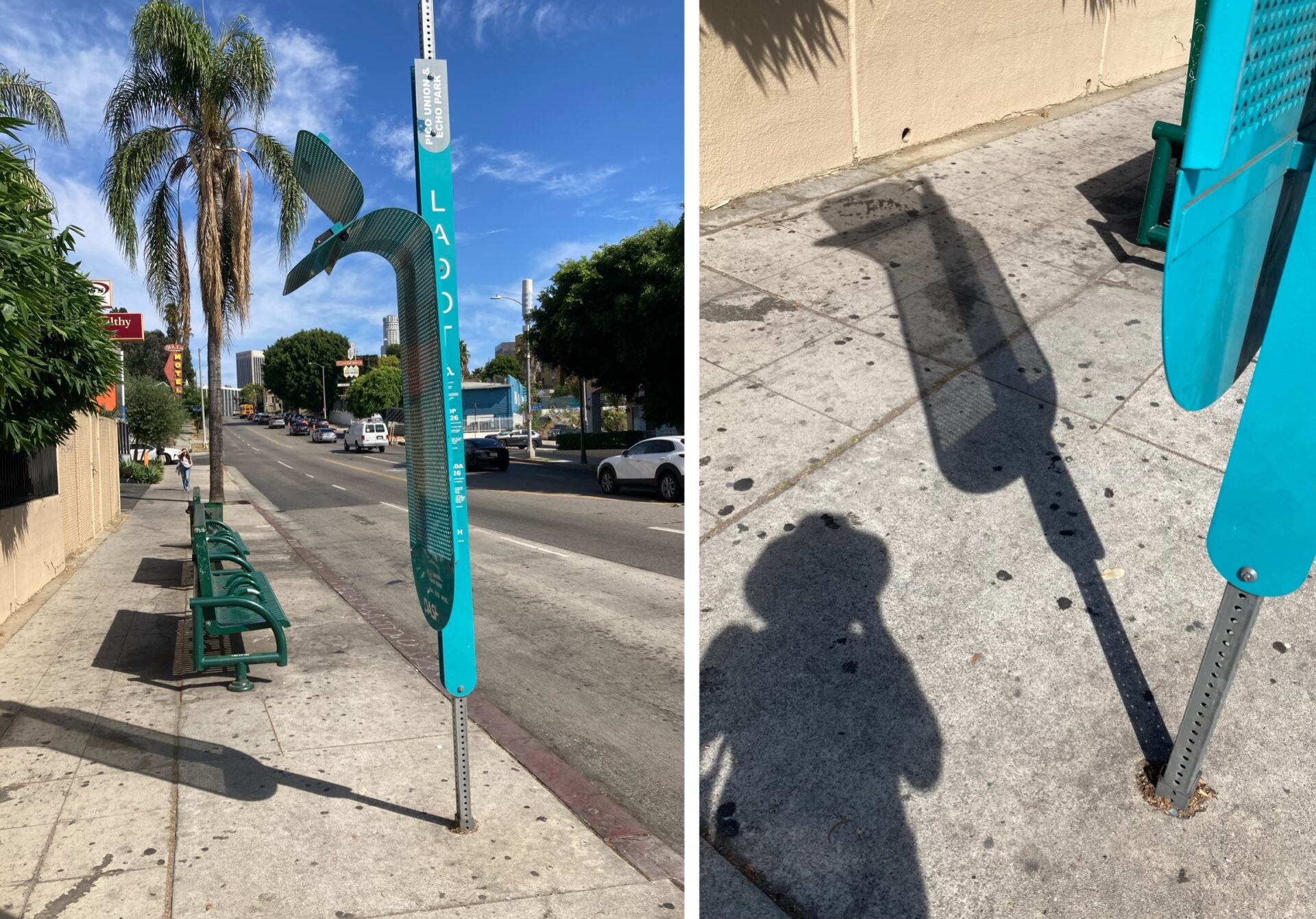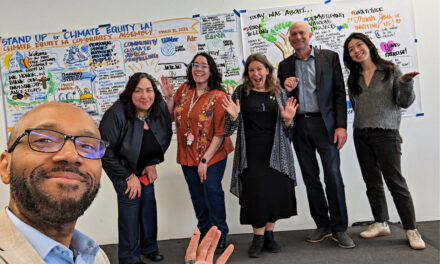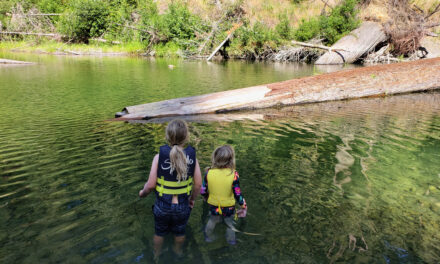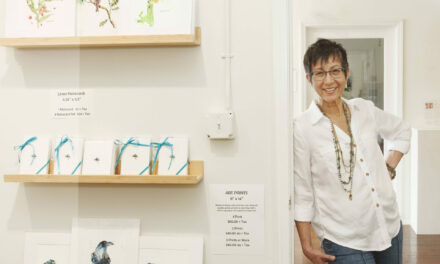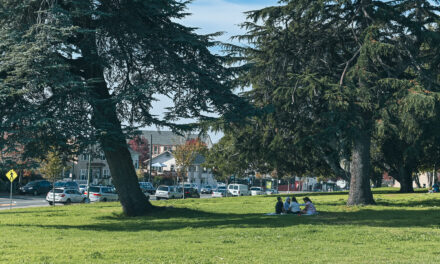Making Shade a Priority in LA: An Interview with Sam Bloch
I first met Sam Bloch, fittingly, at a bus stop in LA. I was there to see La Sombrita, a tall, green, perforated metal bus shade that went viral for providing only a minuscule amount of protection from the sun.
In 2019, Bloch’s article about the inequities of shade in LA went viral. Now, his new book “Shade: The Promise of a Forgotten Natural Resource” is out. It’s a long-form meditation on the nature and function of shade in cities, and a critique of how LA fails to protect its most vulnerable residents from the sun.
We talked about how many Americans don’t stand on sidewalks, how you get something like La Sombrita in the first place, how cities weaponize sunlight against “undesirable” people, and whether or not LA has made progress on its shade goals.
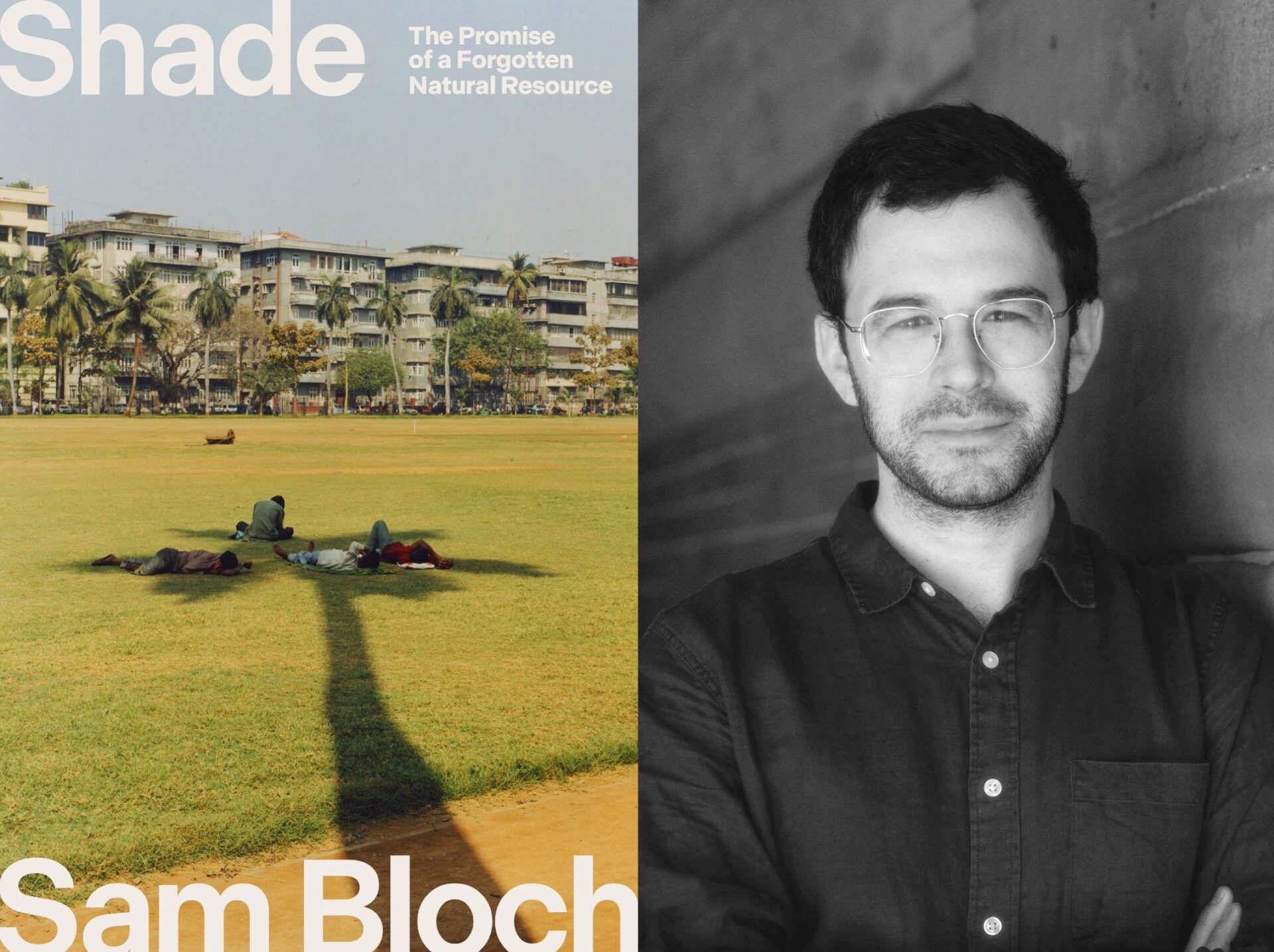
Book cover and author.
Q: The book started with an article about shade. Can you talk about how you came to write the article?
I got interested in shade because of bus stops. I live in New York now, but I lived in LA in the 2000s and 2010s [mostly in] Mount Washington, a cool, shaded, tree-filled neighborhood. In fact, the tree canopy cover is somewhere around 50%, easily one of LA’s shadiest neighborhoods.
I don’t think I really appreciated how shady it was until I started paying attention to what the neighborhoods around it looked like. I would pass by streets where there were no trees at all and bus stops where passengers were waiting for rides, standing behind street signs and telephone poles, trying to catch a little sliver of shadow to get out of the sun. That was the reality I observed through the window of my air-conditioned car.
But that was the reality, not just for the riders in my neighborhood, but also for the hundreds of thousands of people who ride a bus in LA every day. Within city limits, three quarters of [bus stops] have no dedicated shelter where they can sit and get out of the sun.
It didn’t seem fair to me, especially in a city like LA that’s getting hotter and drier every year and the heat is becoming more extreme and more dangerous, especially for transit riders who not only are exposed to that heat just by virtue of the long waits in the sun for the bus, but also who are demographically the most vulnerable to the health effects of heat because of their socioeconomic status.
I tell the story in my article about this guy, Tony Cornejo, this barber who was seeing people standing in the sun suffering. He built his own DIY bus shelter because the city refused to, and it was this beautiful thing. He made something out of nothing, and people in the neighborhood appreciated it. But when the city caught wind of it, they decreed it to be illegal, a sidewalk obstruction, and made him take it down right before the worst heat wave in 25 years rolled through LA.
Since then, for the past 10 years, I’ve been thinking about, how did it get to be this way? Why is this thing so basic and elemental actually really hard to find in LA and actually actively punished?
Q: Has anything changed?
I’ll go on radio shows to talk about shade, and pretty consistently I get calls from people who want to talk about the need for shading parking lots, because that is the way that most people in America get around — in cars. Even the idea that the bus stop would be a location of inquiry or a location to advocate for is foreign to a lot of Americans who simply don’t stand on sidewalks.
One of the LA Metro commissioners, Janice Hahn, famously sometimes takes the bus to her board meetings. That only one transit commissioner sometimes takes public transit to the public transit meeting is perceived as a big win in transit circles just speaks to how rare that experience of standing on the sidewalk is for people.
Culturally, there’s been progress, but materially, in terms of making more shade in LA, we’re still lacking.
I do think it’s now a more mainstream issue. And I’m not even going to credit my article and my reporting on this. I’m going to credit La Sombrita, because it was such a huge debacle. A lot of people in LA started to think about the shoddy state of sidewalks and bus stops and about shade as something that the city is failing to do.
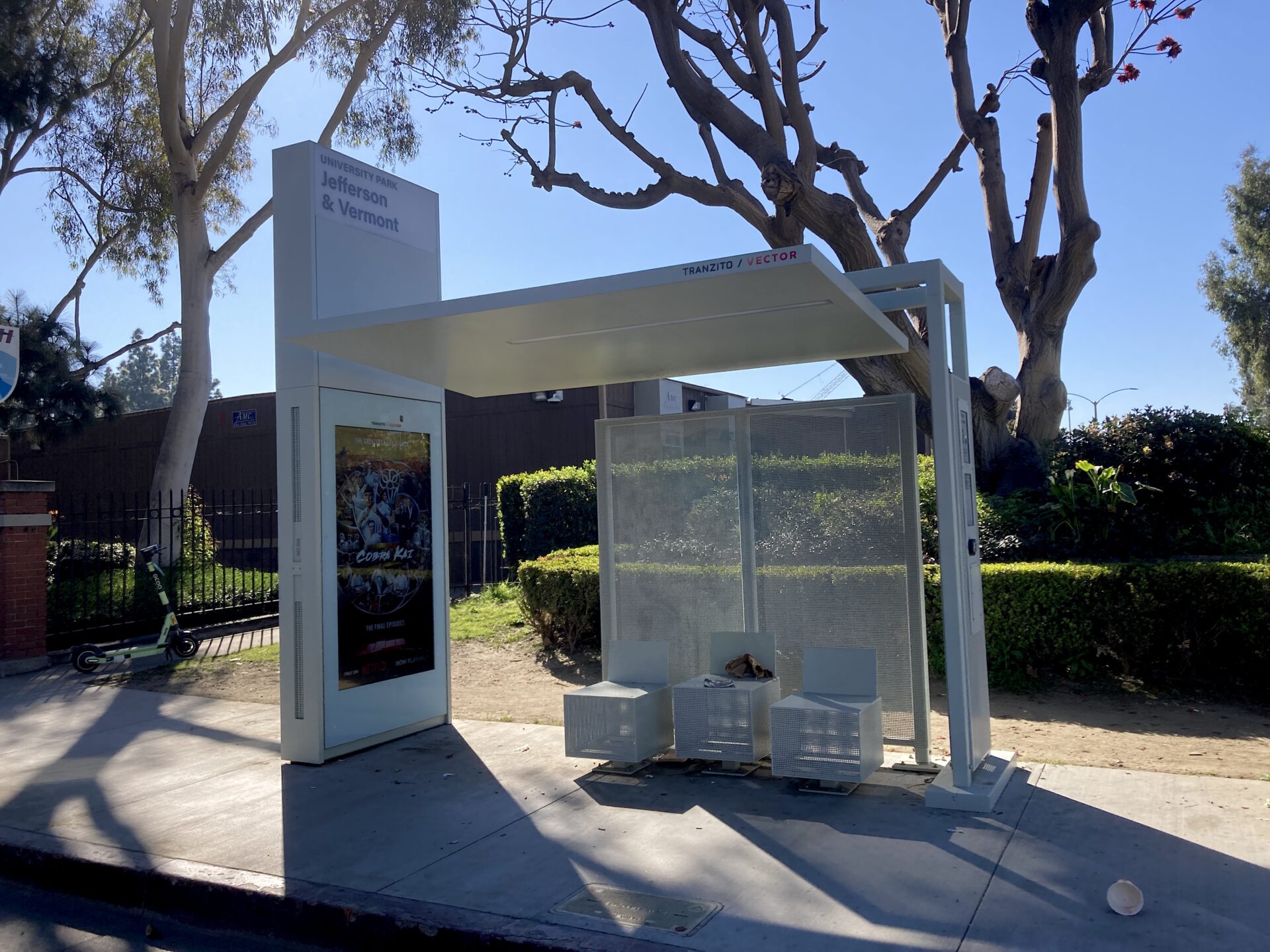
Of the 8,100 bus stops in Los Angeles, the city has built 213 of these new shelters since 2023 (the goal is 3,000). Photo: Maylin Tu
Q: Do you think that people got [La Sombrita] right? Wrong?
It’s taken on a life of its own. No one actually knows what it is, they just know it’s this joke or material representation of municipal dysfunction.
Pedestrians and bus riders are not prioritized, and they are basically given scraps and made to feel appreciative of that.
The designers and the LA Department of Transportation wanted to do something quickly, and they felt they could not work with the other city agencies that control street space.
The streets are never going to be safe, and LA is never going to be climate resilient if the streets department refuses to work with the transportation department and they refuse to work with the engineering department. All these agencies have to be on the same page and aligned behind a capital infrastructure plan that prioritizes climate resiliency.
Q: Why is it so hard for them to work together?
The bureaucracy and red tape might be so onerous and so difficult to navigate that agencies rightly worry that their projects are going to get slowed down or maybe scuttled entirely if they have to go through these collaborative channels. But when you don’t collaborate and you don’t plan together, then you get shit like La Sombrita.
Q: In the book, you introduce characters who are affected by the heat or trying to mitigate heat. And one of those people, Debbie Stevens Browder, is living in her car.
The homeless are so much more vulnerable to heat because, like transit riders, they are just exposed to it. They spend more time outside. And unlike the rest of us, who can hide from the heat in the air conditioning, they often have no escape. Homeless people are far, far, far more likely to die from heat exposure than housed people. In Phoenix, officials say that homeless people are 200 to 300 times more likely to die from heat than a housed person.
We regrettably see these bus shelters where you have homeless people sleeping because they have nowhere else to stay. We — myself included — might scoff, like, ‘Oh, now that space is unusable,’ but they have nowhere else to go. Obviously, the answer for homelessness is not more shade, the answer for homelessness is building more housing. But people who live on the street are vulnerable, and they need protection, and it’s tragic and sadistic when city officials and police officers and homeowners conspire to remove their shade cover to spite them or to get them to move their problems elsewhere.
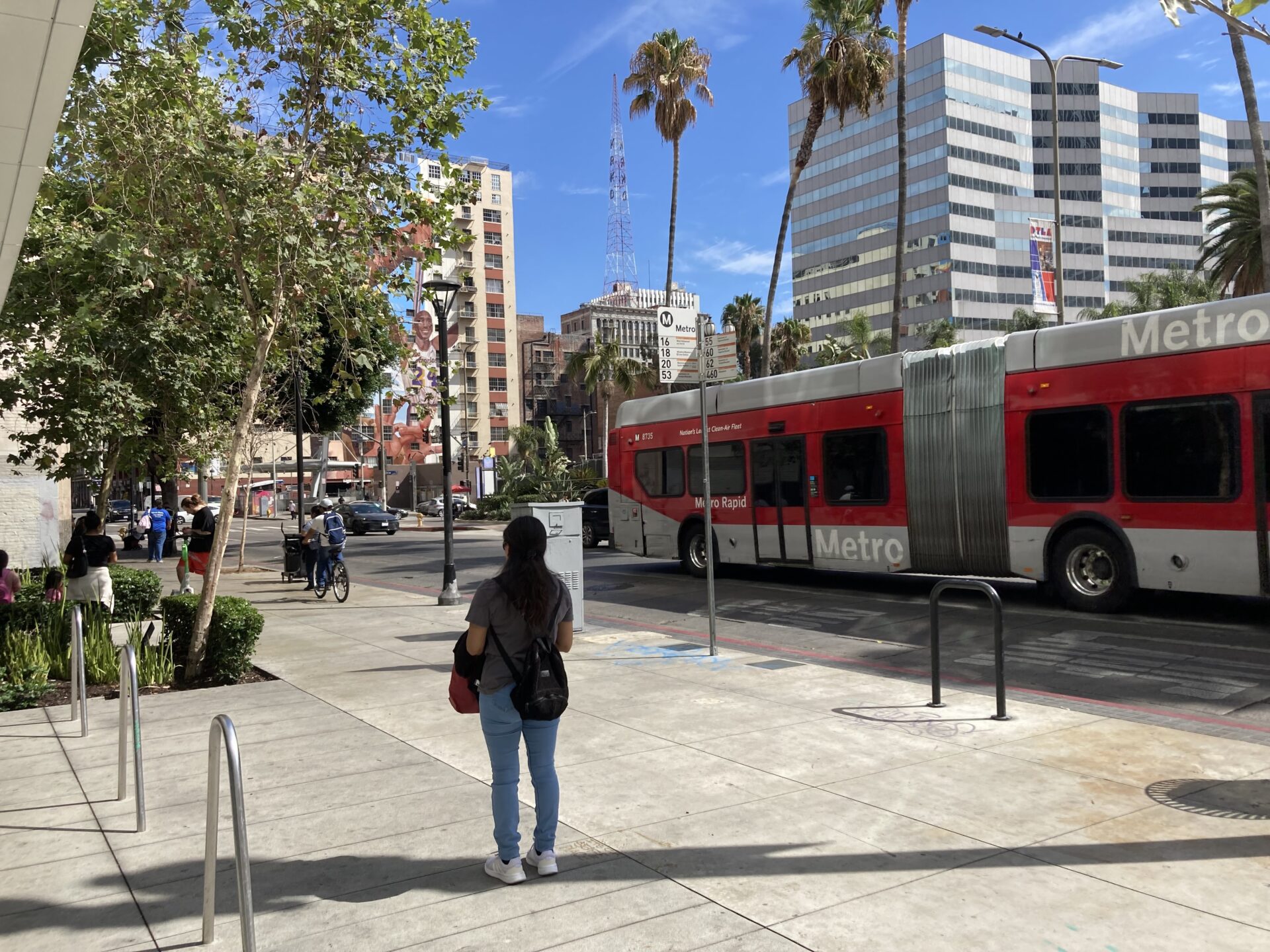
Photo: Maylin Tu
Q: Bus shelters are being funded through advertising revenue. The city’s in a budget crisis. Where do you think the money for more shade infrastructure should come from?
I think there are three pots of money that decision makers and policy makers could start to draw down to make a shadier, greener, more equitable, more climate resilient city. Proposition 4 is the new [state-wide] climate bond that passed last year — there’s $10 billion for climate projects.
Measure W is a county parcel tax. Every year, property owners pay 2.5 cents per square foot of impermeable land like roofs, driveways, hardscape, and that goes toward creating stormwater infrastructure projects. Measure W funding could be used to de-pave parking spots and roads and plant them with trees. Trees create shade, and then the soils capture runoff and return it to the aquifers.
Measure M [an LA County sales tax] money could easily be used to rebuild sidewalks and make them big enough to support proper shelters instead of La Sombrita, and to support larger tree wells. Between those three pots of money — two of them are county, one of them is state — that seems like a lot of money that can be used if a decisive, courageous and imaginative policy maker wanted to pursue these projects.
Q: You write about the backlash against shade and “shady people.” How does this look today?
There’s this tradition in reactionary urban design to expose people to sunlight. In turn-of-the-century New York tenement houses, it was believed exposing [residents] to the sun would make them into more upstanding citizens.
[Tenement residents] were believed to be these degenerate immigrants who were physically and morally unhealthy. That weaponizing of sunlight has morphed in LA to getting rid of [homeless people] all together. Shade and sun can be a weapon that people in power wield against and deploy against unwanted members of the public.
This interview has been edited and condensed for clarity.
- Tracking LA Bus Shelter Progress
- Slow Progress on Shade in California’s Hottest Desert Town, April 2025
- Making Shade Where There Isn’t Any, August 2023
FILM
Review: Climate California, A PBS Series
This series doesn’t scream alarm bells so much as it leans close, listening: to communities coughing in the shadow of oil rigs in Kern County, to whale song and bird calls, to the crackle of a cultural burn. Across 10 episodes, the series explores California’s climate pressures where they’re least abstract — in the rhythms of work, migration, and care that bind people and animals to place. “Home is shelter with a story,” narrates writer and director Charles Loi, and “Climate California” tells that story for the state. Here, California is neither apocalypse nor paradise, but something in between: a land of many trajectories — upward, downward, uncertain, still unfolding — a land where the mechanized and the wild argue and intermingle.
The series refuses the usual structure of problem-then-platitude. Environmental justice and action are woven into every narrative, not saved for a solemn PSA tacked on at the end. There aren’t easy answers here, but there’s a reminder that intervention can be swift and simple — spotting an oil leak with a thermal camera and reporting it to the county, or pinging cargo ships when there are whales nearby. The result is bracing, not depressing. “We have the technological and social abilities to create prosperity,” says novelist Kim Stanley Robinson in an early episode. “When we don’t, it’s a failure of imagination.” Review by Sonya Bennett-Brandt. See the Series.
Don’t Miss: Woman at War, An Icelandic Movie
These days, we need more angry women! Forget Greta Thunberg (famously called an angry woman by he-who-shall-not-be-named), meet Halla, who aims to sabotage the aluminum industry in her beautiful corner of Iceland. As an angry woman herself, KneeDeep’s editor enjoyed this eco-women-warrior movie set in a stunning landscape.
Simple, direct, inspiring, and a 97% on Rotten Tomatoes: “Treating its timely themes with a deceptively light touch, Woman at War is easy to enjoy in the moment, yet its impact lingers long after the closing credits roll.”






